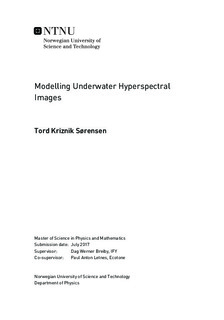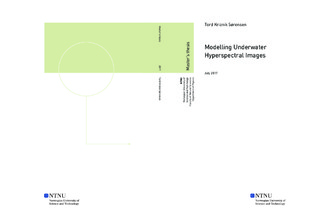| dc.description.abstract | The underwater hyperspectral imager is a new type of imager able to acquire hyperspectral images under water. Common consumer cameras have poor spectral
resolution and only captures light in three bands, in the red, green and blue parts
of the light spectrum. Hyperspectral cameras, on the other hand, might capture hun-
dreds of spectral bands in both the ultraviolet, visible and infrared regime. This
property makes such cameras ideal for automatic mapping and object classification, which is important tools in fields such as environmental mapping.
In this work, we have taken the first steps towards a physical model for images
acquired with an underwater hyperspectral imager. Light is heavily attenuated in
water, and corrections need to be made if measurements from different distances
and water bodies are to be compared. The proposed model consists of three sub-
models: a model describing a lamp, a model for spectrally dependent attenuation
in water and a model for reflectance. The lamp was modelled as a point source
positioned behind the real lamp, emitting light in a Gaussian angular distribution.
Attenuation in water was modelled using radiative transfer theory, and reflectance
using the Oran-Nayar reflectance model. With the proposed model we were able
to describe the collimation of the light well, and the assumed distribution as a reasonable first approximation. The model was also partly able to describe the change
of shape of the light spectra with attenuation.
We have tested classification in underwater hyperspectral images to see the ef-
fect of uneven illumination and attenuation in water on the classification accuracy.
It was also used as a tool for evaluating the proposed model. Uneven illumination and attenuation had a significant effect on classification accuracy, and hence
need to be accounted for in real world applications. Two approaches were tested
for removing these effects: normalisation and estimating reflectances. Normalisation gave a near perfect classification, while estimating reflectances using the
proposed model performed worse than classification on the raw spectra. The es-
timated reflectances had however similar shapes, and it is thus mainly a problem
with estimating the correct magnitudes for the illumination. The preprocessing
method which seems to have the most potential when classifying different water
bodies is to first estimate reflectance, and then normalise. We then circumvent the
problem with illumination, and are able to classify between water bodies as long
as the attenuation is known.
The proposed model performs within the expectations of a first attempt at modelling images acquired with an underwater hyperspectral imager. The developed
simulation- and analysis tools will be useful in further research and field measure-
ments. | |

